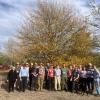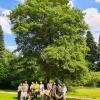Editor's Picks
Plant Focus
Published May 2014 in International Oaks No. 25: 71–84
Abstract
Although the Mirbeck oak, Quercus canariensis Willd., is, or perhaps was, native to Portugal, widespread deforestation has decimated its numbers in the country. It is easier to see in some places in Spain but on both sides of the border this beautiful tree is barely known and rarely used for landscaping. As is typical within this genus, its taxonomy is complicated. The purpose of its marcescence and the mysteries of masting are also open to debate. There is disagreement amongst experts concerning some conservation strategies. But the tree’s need for protection especially in the face of climate change is not in doubt and an ambitious measure to ensure its future in Portugal is described. Comments and criticism are welcome.
Keywords
Quercus canariensis Willd., Q. ×marianica C. Vicioso, Q. ×fagineomirbeckii Villar, carvalho-de-Monchique, quejigo andaluz, conservation, climate change
References
Abadía, A., E. Gil, F. Morales, L. Montañés, G. Montserrat, and J. Abadía. 1996. Marcescence and senescence in a submediterranean oak (Quercus subpyrenaica E.H. del Villar): photosynthetic characteristics and nutrient composition. Plant, Cell & Environment 19(6): 685-694.
Brewer, S., R. Cheddadi, J.L. de Beaulieu, and M. Reille. 2002. The spread of deciduous Quercus throughout Europe since the last glacial period. Forest Ecology and Management 156: 27-48.
Colchester, Marcus. 1998. The Underlying Causes of Deforestation and Forest Degradation in Europe. Synthesis Report of the European Regional Meeting Bonn October 1998. Raincoast Conservation Society.
Canaveira, Paulo, Ana Maria Almeida, João Sousa Teixeira, and R. Oliveira. 1999. Forests and People in the Iberian Peninsula. Synthesis Report of the European Regional Meeting Bonn October 1998. Raincoast Conservation Society.
de Nascimento, Lea, Katherine J. Willis, José María Fernándes-Palacios, Constantino Criado, and Robert J. Whittaker. 2009. The long-term ecology of the lost forests of La Laguna, Tenerife (Canary Islands). Journal of Biogeography 36: 499-514.
Dodd, Richard, and Zara Afzal-Rafii. 2003. Selection and Dispersal in a Multispecies Oak Hybrid Zone. Evolution 58(2): 261- 269.
Ducousso, Alexis. 2012. Endangered Oak Resources in Europe and Around the Mediterranean Basin: Marginal Populations and Minor Species. International Oaks 24: 108-115.
Fairbanks, Richard G. 1989. A 17,000-year glacio-eustatic sea-level record: influence of glacial melting rates on the Younger Dryas event and deep-ocean circulation. Nature 342: 637-642.
Food and Agriculture Organization of the United Nations. 2010. Forest Resource Assessment 2010. Rome.
Gil, Luís, and María Carolina Varela. 2009. Technical guidelines for genetic conservation and use Quercus suber Cork oak. Rome: Euforgen Secretariat.
Govaerts, R., and D.G. Frodin. 1998. World Checklist and Bibliography of Fagales. UK: Royal Botanic Gardens, Kew
Hampe, Arndt. 2013. “Oak Forests Coping with Environmental Change,” workshop, Universidad Internacional de Andalucía, Baeza, Spain.
Hipp, Andrew. 2005. When Oak Leaves Fail to Fall. Plant Health Care Report 2005.03. Chicago: Morton Arboretum. Intergovernmental Panel on Climate Change. 2007. Fourth Assessment Report. Geneva, Switzerland: World Meteorological Organization.
Kaplan, Jed O, Kristen M. Krumhardt, and Niklaus Zimmermann. 2009. The prehistoric and preindustrial deforestation of Europe. Quaternary Science Reviews 28: 3016-3034.
Kew Royal Botanic Gardens, UK. 2013. World Checklist of Selected Plant Families. http://apps.kew.org/wcsp/synonomy.do;jsessionid=FB2E7749E76FDD3E54F813C196F43815?name_id=171953. Keyes, Ralph. 2006. The Quote Verifier. New York: St. Martin’s Press.
Oliveira, P. 2006. A análise isoenzimática na identificação de híbridos de sobreiro e azinheira. Prova de Doutoramento. Portugal: Universidade de Évora.
Pascual, Marcos Salas, and María Teresa Cáceres Lorenzo. 2000. Datos Históricos de la Presencia de Fitónimos relacionados con el Género Quercus L. en Canarias. Vegueta, 5: 341-347.
Pearse, Ian and Walt Koenig. 2012. Acorns, Acorns Everywhere, But Not in Every Year. International Oaks 24: 116-121.
Pérez-Ramos, I.M., Ourcival, J.M., Limousin, J.M. & Rambal, S. 2010. Mast seeding under increasing drought: results from a long-term data set and from a rainfall exclusion experiment. Ecology 91(10): 3057-3068.
Petit, Rémy J., Arndt Hampe, and Rachid Cheddadi. 2005. Climate changes and tree phylogeography in the Mediterranean. Taxon 54(4): 877-885.
Real Jardín Botánico. 2013. Flora ibérica. Plantas vasculares de la Península Ibérica e Islas Baleares. Spain. http://www.floraiberica.es/eng/PHP/cientificos2.php?gen=Quercus&espe=canariensis&infrank=_&infra=_&autabre=Willd.&familia=Fag aceae.
Rivas-Martínez, Salvador. 2007. Mapa de series, geoseries y geopermaseries de vegetación de España I. Itinera Geobotanica 17: 1-435.
Schaffer, M.L. 1981. Minimum population sizes for species conservation. BioScience 31(2): 131-134.
Stern, Nicholas. 2006. Stern Review on the Economics of Climate Change. UK: H.M. Treasury Cabinet Office.
Svendsen, C. R. 2001. Effects of marcescent leaves on winter browsing by large herbivores in northern temperate deciduous forests. Alces 37(2): 475-482.
Svenning, Jens-Chrisitian, and Flemming Skov. 2004. Limited filling of the potential range in European tree species. Ecology Letters 7(7): 565-573.
Vila-Viçosa, Carlos. 2012. Os Carvalhais Marcescentes do Centro e Sul de Portugal—Estudo e Conservação. Portugal: Universidade de Évora & Instituto Superior de Agronomia – UTL.
World Bank. 2013. Development Indicators 2013. http://data.worldbank.org/data-catalog/world-development-indicators
Yale University, USA. 2012. Environmental Performance Index 2012. http://epi.yale.edu/epi2012/rankings















